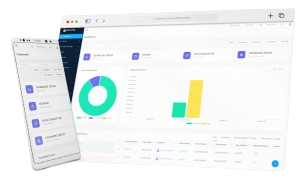Cloud-based inventory management system is a game-changer for retailers, offering real-time access to stock levels, streamlined processes, and the ability to manage inventory from anywhere.
In today’s fast-paced retail environment, relying on outdated methods like spreadsheets or manual counts can lead to stockouts, overstocking, and costly errors. By adopting a cloud-based system, retailers can optimize their operations, improve customer satisfaction, and make smarter business decisions—all while saving time and money.
What Is a Cloud-Based Inventory Management System?
A cloud-based inventory management system is software that allows businesses to track, manage, and update their stock in real-time through the Internet. Instead of relying on local servers or spreadsheets, all inventory data is stored on remote cloud servers, making it accessible from any device. This system provides real-time updates on stock levels, integrates with other tools like POS systems, and automates reordering when stock is low, streamlining the entire inventory process for retailers.
Benefits of Cloud-Based Inventory Management for Retailers
Cloud-based inventory management systems offer several advantages that can transform your retail operations:
- Real-Time Data Access
You no longer need to rely on outdated spreadsheets or manual counts. Cloud systems provide up-to-the-minute stock data, so you always know what’s available, what’s running low, and when to reorder. This helps prevent costly stockouts and missed sales. - Lower Operational Costs
Cloud-based systems eliminate the need for expensive hardware or complex IT infrastructure. With automated processes and real-time updates, you reduce human error and free up valuable time, allowing you to focus on growing your business. - Automated Reordering
Forget the hassle of manually tracking stock levels. These systems automatically alert you when stock is low and can even place orders with suppliers, ensuring you always have the right products on hand. - Scalability and Flexibility
Whether you have one store or multiple locations, a cloud-based system grows with your business. You can easily add new features or integrate with existing tools without disruption, keeping everything running smoothly as your business expands. - Enhanced Inventory Forecasting
By analyzing past sales and inventory trends, cloud-based systems help you predict future demand more accurately. This lets you make smarter purchasing decisions, avoiding overstocking or understocking critical items. - Access from Anywhere
Whether you’re in-store, at home, or on the go, you can manage your inventory from any device with an internet connection. This flexibility allows you to stay on top of your operations wherever you are.
In short, cloud-based inventory management helps retailers save time, reduce costs, and keep operations efficient, ensuring your business runs smoothly and stays competitive.
Key Features to Look For in a Cloud-Based Inventory System
When choosing a cloud-based inventory management system, it’s important to ensure it has the essential features that make managing stock easier and more efficient. Here’s what to look for:
- Real-Time Inventory Tracking
A good system offers real-time updates, so you always know your exact stock levels. This helps prevent stockouts and overstocking, ensuring that you have the right amount of products available at the right time. - Multi-Location Management
Whether you’re managing inventory for multiple stores, warehouses, or online sales channels, a cloud system should let you track everything from a central platform. This simplifies stock management across different locations and makes it easier to allocate resources where they’re needed. - Demand Forecasting
The system should analyze sales data to help you predict future inventory needs. Accurate demand forecasting prevents over-ordering or under-ordering, helping you maintain optimal stock levels and reduce waste. - Integration with Sales Channels and Other Tools
Seamless integration with your POS system, e-commerce platforms, and shipping tools is essential. This ensures that your inventory data is automatically updated as you make sales or receive new stock, streamlining your entire retail operation. - Automated Reordering and Alerts
Look for a system that alerts you when stock is running low and can automate the reordering process. This minimizes the risk of stockouts and helps you maintain a consistent product supply without manual intervention. - Mobile Access
With cloud-based systems, you should be able to manage your inventory from any device—whether it’s your phone, tablet, or laptop. This flexibility is crucial for business owners who need to keep track of stock while on the go. - Detailed Reporting and Analytics
Comprehensive reporting tools allow you to track sales trends, inventory turnover, and best-selling products. These insights help you make data-driven decisions to optimize your stock and improve overall profitability.
A well-rounded cloud-based inventory system includes all these features to ensure your retail business operates smoothly, efficiently, and profitably.
Best Practices for Implementing a Cloud-Based Inventory Management System

Switching to a cloud-based inventory management system can streamline your operations, but getting the most out of it requires a thoughtful approach. Here are some best practices to ensure a smooth and effective implementation:
- Train Your Team
A cloud-based system is only as effective as the people using it. Make sure your staff is properly trained on how to use the new system. Conduct thorough onboarding sessions and offer ongoing training to ensure everyone understands the features and can handle day-to-day tasks confidently. learn how to train your employees on new inventory management and POS. - Start with a Clean Inventory
Before transitioning to a cloud-based system, clean up your current inventory data. Remove obsolete or incorrect records, and make sure stock levels are accurate. This ensures that the data imported into the new system is reliable from day one. - Integrate with Your POS and Other Systems
Maximize efficiency by integrating your cloud-based inventory system with your POS, accounting software, and e-commerce platforms. This keeps your stock data updated in real-time across all sales channels, minimizing discrepancies and saving you time on manual updates. - Automate Where Possible
Take advantage of the automation features that cloud-based systems offer. Set up automatic stock alerts, reordering triggers, and inventory updates. Automation not only reduces human error but also frees up your team to focus on more important tasks like customer service and sales. - Conduct Regular Audits
Even with a cloud-based system, regular inventory audits are crucial. Periodically check physical stock against the system to ensure everything matches up. This helps you identify and fix any discrepancies early on, keeping your inventory data accurate. - Monitor Key Metrics
Leverage the reporting and analytics tools built into your system to monitor key inventory metrics such as turnover rates, stock levels, and sales trends. Use this data to make informed decisions about ordering, pricing, and promotions, ensuring your inventory aligns with customer demand. - Start Small, Scale Gradually
When implementing a cloud-based system, start with a single location or department to familiarize yourself with the platform. Once you’re confident with the system’s capabilities, gradually roll it out across other locations or expand its features to meet growing business needs.

By following these best practices, you’ll be able to fully harness the power of a cloud-based inventory system, ensuring smoother operations, better stock control, and improved business efficiency.
Choosing the Right Cloud-Based Inventory Management System

Selecting the right cloud-based inventory management system is a critical decision for any retailer. Here’s how to make sure you choose the best fit for your business:
- Evaluate Your Business Needs
Start by assessing your current inventory challenges. Do you need better real-time tracking, improved demand forecasting, or multi-location management? Understanding your specific pain points will help you identify the features you need most in a cloud-based system. - Consider Integration Capabilities
Look for a system that integrates seamlessly with your existing tools, like your POS system, e-commerce platforms, and accounting software. The more integrations available, the more streamlined your operations will be, ensuring all your sales channels and back-end processes are connected. - Scalability
As your business grows, your inventory needs will evolve. Choose a system that can scale with you, whether that means adding new sales channels, locations, or advanced features like automated reordering or warehouse management. This ensures that your system won’t hold you back as your business expands. - Ease of Use
Your cloud-based system should be user-friendly, both for you and your staff. Opt for a platform with an intuitive interface that makes it easy to manage inventory, train employees, and access data on any device. A system that’s difficult to navigate can lead to inefficiencies and mistakes. - Cost and Budget Considerations
While cloud-based systems are generally more affordable than traditional ones, make sure to choose a solution that fits your budget. Look for transparent pricing models, usually based on a monthly subscription, and avoid systems with hidden fees or excessive costs for scaling up. - Customer Support and Training
Reliable customer support is essential when you’re implementing new technology. Ensure the vendor provides comprehensive support and training resources to help you and your team get the most out of the system, whether through tutorials, live chat, or phone support. - Review Reporting and Analytics Features
Strong reporting capabilities are essential for making data-driven decisions. Choose a system that offers detailed reports on inventory turnover, sales trends, and stock levels, allowing you to make informed decisions about purchasing, pricing, and promotions.
By focusing on these factors, you’ll be able to select a cloud-based inventory management system that fits your current needs and supports your long-term growth.
Conclusion: Cloud-Based Inventory Is the Future of Retail
Cloud-based inventory management systems are transforming how retailers manage stock, streamline operations, and respond to customer demand. By offering real-time access to inventory data, automating key processes, and integrating with other vital tools, these systems ensure retailers stay competitive in today’s fast-paced market.
Choosing the right cloud-based inventory management system not only improves accuracy and efficiency but also scales with your business as it grows. Whether you’re managing a single store or multiple locations, a cloud-based inventory management system helps you optimize stock levels, reduce costs, and make data-driven decisions that enhance profitability.
As retail continues to evolve, adopting a cloud-based inventory management system will be key to staying ahead of the curve and meeting customer expectations. The future of retail lies in these flexible, powerful systems that keep your business agile and responsive to change






